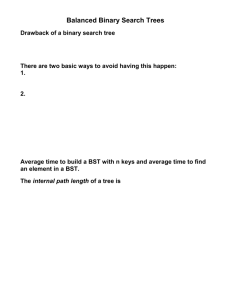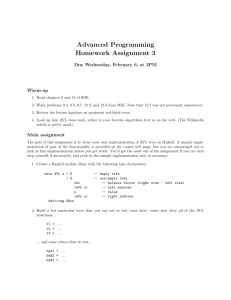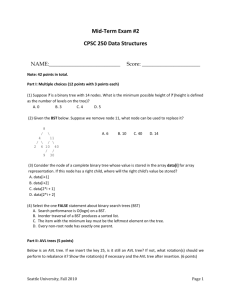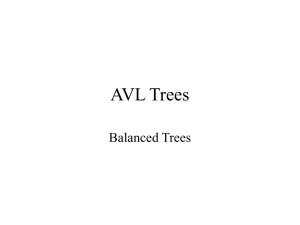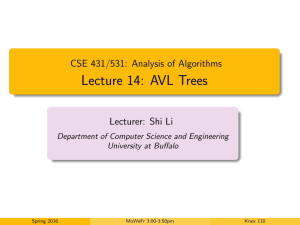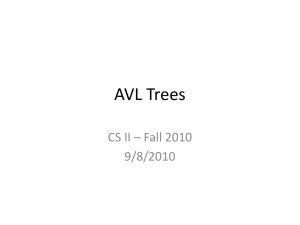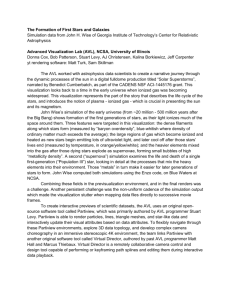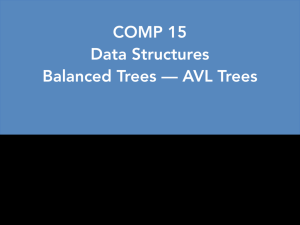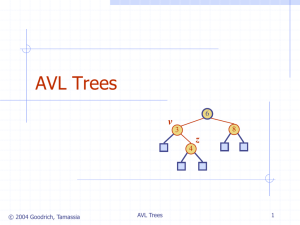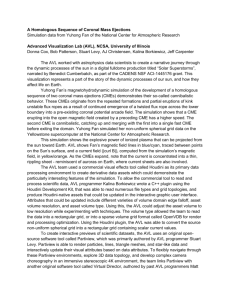Lec-13-AVL-Trees
advertisement
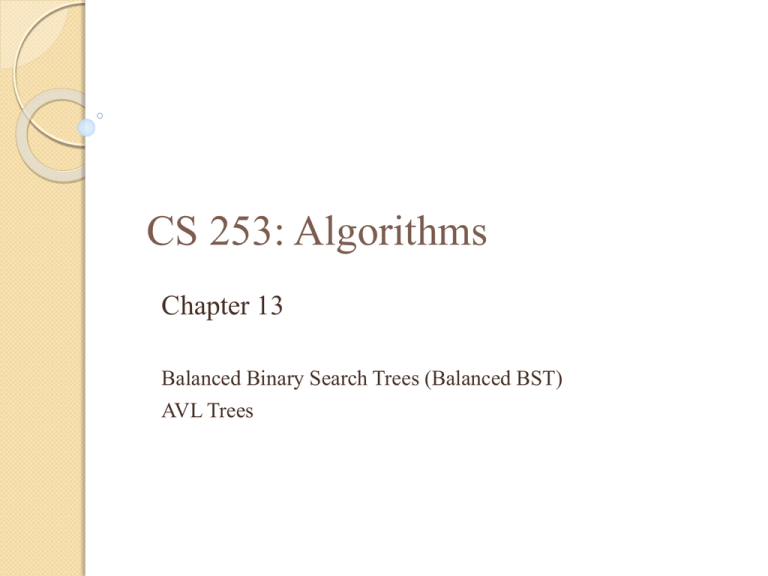
CS 253: Algorithms Chapter 13 Balanced Binary Search Trees (Balanced BST) AVL Trees Binary Search Trees - Summary Operations on binary search trees: ◦ SEARCH O(h) ◦ PREDECESSOR O(h) ◦ SUCCESSOR O(h) ◦ MINIMUM O(h) ◦ MAXIMUM O(h) ◦ INSERT O(h) ◦ DELETE O(h) These operations are fast if the height of the tree is small Theorem 12.4 The expected height of a randomly built binary search tree on n distinct keys is O(lgn) Can we make sure that 2 h = O(lgn) ? Balance • To achieve logarithmic performance for dictionary operations (Search, Predecessor, Successor, Insert/Delete, Min/Max), we need to guarantee that we have a balanced Binary Search Tree (BST). • In a balanced BST, we can afford to increase the number of nodes exponentially (e.g. 2k, because each op takes O(log(2k)) = O(k)) • In general, we refer to BSTs that achieve this performance through some kinds of balancing rules or actions as balanced search trees. AVL Trees Height-balance Property: For every internal node v of T, the heights of the children of v can differ by at most 1. An AVL Tree Example: AVL Trees A non-AVL Tree Example: Theorem: The height of an AVL tree, T, storing n items is O(log n). Proof: Let’s call nh to be the minimum number of internal nodes of an AVL tree with height h. Base cases: n1 = 1, an AVL tree of height 1 must have at least one internal node n2 = 2, an AVL tree of height 2 must have at least two internal nodes. General case for height, h ≥ 3: nh = 1 + nh−1 + nh−2 Note that nh values are strictly increasing as h increases (similar to the Fibonacci sequence). In other words, nh−1 > nh−2, for h ≥ 3, which allows us to simplify the above formula as: nh > 2nh−2 i.e. nh at least doubles each time h increases by 2. Which implies that nh > 2k *nh-2k (choose h-2k = 2) nh > 2h/2 By taking logarithms of both sides, we obtain log nh > h/2 h < 2 log nh < 2 log n Therefore, an AVL tree with n keys has height h < 2 log n h = O(log n) Trinode restructuring • involves a node, x, which has a parent, y, and a grandparent, z. • A trinode restructure temporarily renames the nodes x, y, and z as a, b, and c, so that a precedes b and b precedes c in an inorder traversal of T. Algorithm restructure(x): Input: A node x of a BST T that has both a parent y and a grandparent z Output: Tree T after a trinode restructuring (which corresponds to a single or double rotation) involving nodes x, y, and z 1: Let (a, b, c) be a left-to-right (inorder) listing of the nodes x, y, and z, and let (T0, T1, T2, T3) be a left-to-right (inorder) listing of the four subtrees of x, y, and z not rooted at x, y, or z. 2: Replace the subtree rooted at z with a new subtree rooted at b. 3: Let a be the left child of b and let T0 and T1 be the left and right subtrees of a, respectively. 4: Let c be the right child of b and let T2 and T3 be the left and right subtrees of c, respectively. Rotations • The trinode restructure method modifies parent-child relationships of O(1) nodes in T, while preserving the inorder traversal ordering of all the nodes in T. • In addition to its order-preserving property, a trinode restructuring operation changes the heights of nodes in T, so as to restore balance. • restructure(x) is typically executed when z, the grandparent of x, is unbalanced. Moreover, this unbalance is due to one of the children of x now having too large a height relative to the height of z’s other child. • Move up the “tall” child of x while pushing down the “short” child of z. Thus, after performing restructure(x), all the nodes in the subtree now rooted at the node b are more balanced. Trinode restructuring example for an AVL Tree • involves a node, x, which has a parent, y, and a grandparent, z.
